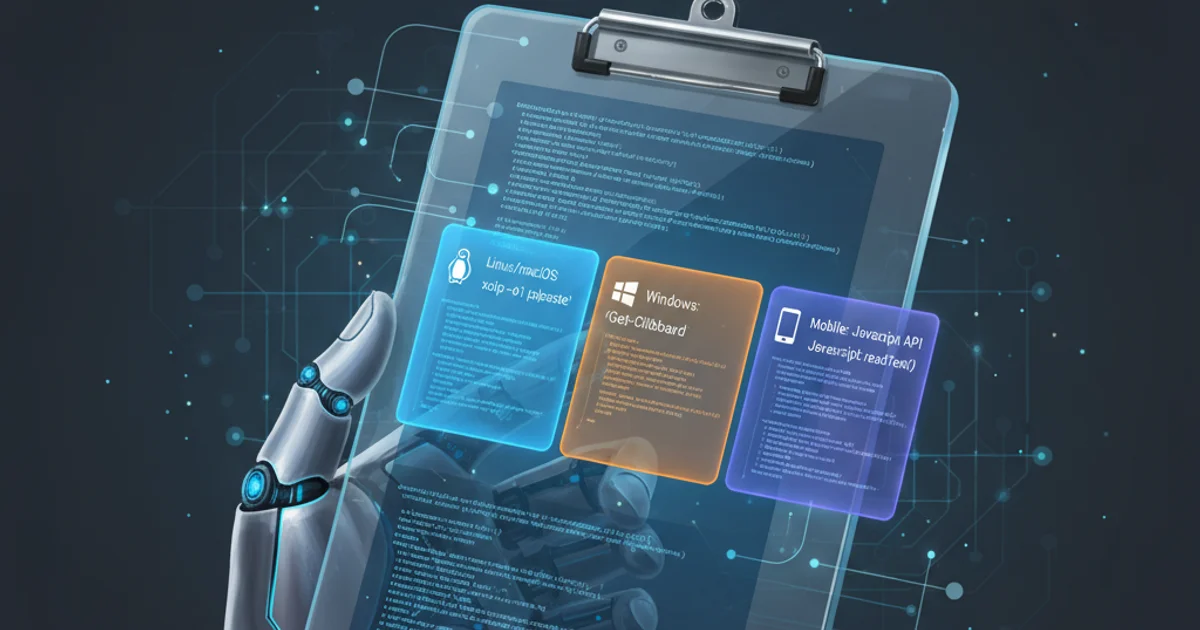My custom "paste from clipboard" action
Categories:
Crafting Your Own Cross-Platform Clipboard Paste Action

Learn to implement a custom 'paste from clipboard' action in Java and C++ for both Linux and Windows, overcoming common platform-specific challenges.
Implementing a custom 'paste from clipboard' action can be a surprisingly complex task, especially when targeting multiple operating systems like Linux and Windows. The underlying mechanisms for accessing and manipulating clipboard data differ significantly between platforms. This article will guide you through the process, providing insights and code examples for both Java and C++ to help you build robust, cross-platform clipboard functionality.
Understanding Clipboard Mechanisms
Before diving into code, it's crucial to understand how clipboards work on different operating systems. Windows uses a message-based system, where applications register as clipboard viewers or owners. Linux, particularly X11-based environments, uses selections (PRIMARY, SECONDARY, CLIPBOARD) and relies on inter-client communication protocols. Java provides a high-level java.awt.datatransfer API that abstracts much of this complexity, but understanding the native layers is beneficial for advanced scenarios or debugging.
flowchart TD
A[Application Initiates Paste] --> B{Operating System?}
B -->|Windows| C[Windows API: GetClipboardData]
B -->|Linux (X11)| D[X11 Selection Protocol]
C --> E{Data Format?}
D --> F{Data Format?}
E --> G[Retrieve Text/Image/File]
F --> G
G --> H[Application Processes Data]
H --> I[Custom Paste Action]High-level flow of a custom paste action across operating systems.
Implementing in Java (Cross-Platform)
Java's java.awt.datatransfer package offers a relatively straightforward way to interact with the system clipboard. The Toolkit.getDefaultToolkit().getSystemClipboard() method provides access to the clipboard, and you can use Transferable objects to get or set data. The key is to check for available data flavors (e.g., DataFlavor.stringFlavor for text) to handle different types of content.
import java.awt.Toolkit;
import java.awt.datatransfer.*;
import java.io.IOException;
public class JavaClipboardPaste {
public static String pasteText() {
Clipboard clipboard = Toolkit.getDefaultToolkit().getSystemClipboard();
Transferable contents = clipboard.getContents(null);
if (contents != null && contents.isDataFlavorSupported(DataFlavor.stringFlavor)) {
try {
return (String) contents.getTransferData(DataFlavor.stringFlavor);
} catch (UnsupportedFlavorException | IOException e) {
System.err.println("Error pasting text: " + e.getMessage());
e.printStackTrace();
}
}
return null;
}
public static void main(String[] args) {
String pastedContent = pasteText();
if (pastedContent != null) {
System.out.println("Pasted from clipboard:\n" + pastedContent);
} else {
System.out.println("No text found on clipboard or error occurred.");
}
}
}
Java code to retrieve text from the system clipboard.
DataFlavor types, such as DataFlavor.imageFlavor or DataFlavor.javaFileListFlavor, and cast the retrieved data accordingly.Implementing in C++ (Platform-Specific)
For C++, clipboard interaction is highly platform-dependent. You'll need to use Windows API functions for Windows and X11 functions for Linux. This often involves more boilerplate code and careful handling of memory and data formats.
Windows (C++)
#include <windows.h>
#include
std::string pasteTextFromClipboard_Windows() { if (!OpenClipboard(NULL)) { std::cerr << "Failed to open clipboard." << std::endl; return ""; }
HANDLE hData = GetClipboardData(CF_TEXT);
if (hData == NULL) {
CloseClipboard();
std::cerr << "No text data on clipboard." << std::endl;
return "";
}
char* pszText = static_cast<char*>(GlobalLock(hData));
if (pszText == NULL) {
CloseClipboard();
std::cerr << "Failed to lock clipboard data." << std::endl;
return "";
}
std::string text(pszText);
GlobalUnlock(hData);
CloseClipboard();
return text;
}
int main() { std::string pastedContent = pasteTextFromClipboard_Windows(); if (!pastedContent.empty()) { std::cout << "Pasted from clipboard (Windows):\n" << pastedContent << std::endl; } else { std::cout << "No text found on clipboard or error occurred (Windows)." << std::endl; } return 0; }
Linux (C++ with X11)
#include <X11/Xlib.h>
#include <X11/Xatom.h>
#include
// Compile with: g++ -o clipboard_paste clipboard_paste.cpp -lX11
std::string pasteTextFromClipboard_X11() { Display* display = XOpenDisplay(NULL); if (display == NULL) { std::cerr << "Cannot open display." << std::endl; return ""; }
Window root = DefaultRootWindow(display);
Window owner = XGetSelectionOwner(display, XA_PRIMARY);
if (owner == None) {
owner = XGetSelectionOwner(display, XInternAtom(display, "CLIPBOARD", False));
}
if (owner == None) {
XCloseDisplay(display);
std::cerr << "No clipboard owner found." << std::endl;
return "";
}
Window requestor = XCreateSimpleWindow(display, root, 0, 0, 1, 1, 0, 0, 0);
Atom UTF8_STRING = XInternAtom(display, "UTF8_STRING", False);
Atom XSEL_DATA = XInternAtom(display, "XSEL_DATA", False);
XConvertSelection(display, XA_PRIMARY, UTF8_STRING, XSEL_DATA, requestor, CurrentTime);
XEvent event;
std::string clipboardText;
while (true) {
XNextEvent(display, &event);
if (event.type == SelectionNotify) {
if (event.xselection.property == None) {
std::cerr << "Selection conversion failed." << std::endl;
break;
}
Atom actual_type;
int actual_format;
unsigned long nitems, bytes_after;
unsigned char* data = NULL;
XGetWindowProperty(display, requestor, XSEL_DATA, 0, ~0L, False, AnyPropertyType,
&actual_type, &actual_format, &nitems, &bytes_after, &data);
if (data != NULL) {
clipboardText = std::string(reinterpret_cast<char*>(data), nitems);
XFree(data);
}
break;
}
}
XDestroyWindow(display, requestor);
XCloseDisplay(display);
return clipboardText;
}
int main() { std::string pastedContent = pasteTextFromClipboard_X11(); if (!pastedContent.empty()) { std::cout << "Pasted from clipboard (X11):\n" << pastedContent << std::endl; } else { std::cout << "No text found on clipboard or error occurred (X11)." << std::endl; } return 0; }
GlobalLock/GlobalUnlock on Windows, XFree on X11) to prevent memory leaks. Also, consider character encodings; UTF-8 is generally preferred for cross-platform compatibility.Integrating Custom Paste into Applications
Once you have the core clipboard retrieval logic, integrating it into your application involves triggering the paste action from a UI event (e.g., a menu item, a keyboard shortcut). For GUI applications, you'll typically have an event handler that calls your custom paste function and then inserts the retrieved text into a text field or other appropriate control.
1. Define the Paste Trigger
Identify how users will initiate the paste. This could be a 'Paste' menu item, a button, or a keyboard shortcut like Ctrl+V (Windows/Linux) or Cmd+V (macOS).
2. Call the Clipboard Retrieval Function
In the event handler for your paste trigger, call the appropriate clipboard retrieval function (e.g., JavaClipboardPaste.pasteText() or pasteTextFromClipboard_Windows()).
3. Process and Insert Data
Receive the data from the clipboard. If it's text, insert it into the currently focused text input field. If it's another data type (like an image), handle it according to your application's requirements (e.g., display the image, save the file).
4. Handle Errors and Empty Clipboard
Implement robust error handling for cases where the clipboard is empty, contains unsupported data types, or native API calls fail. Provide user feedback if a paste operation cannot be completed.